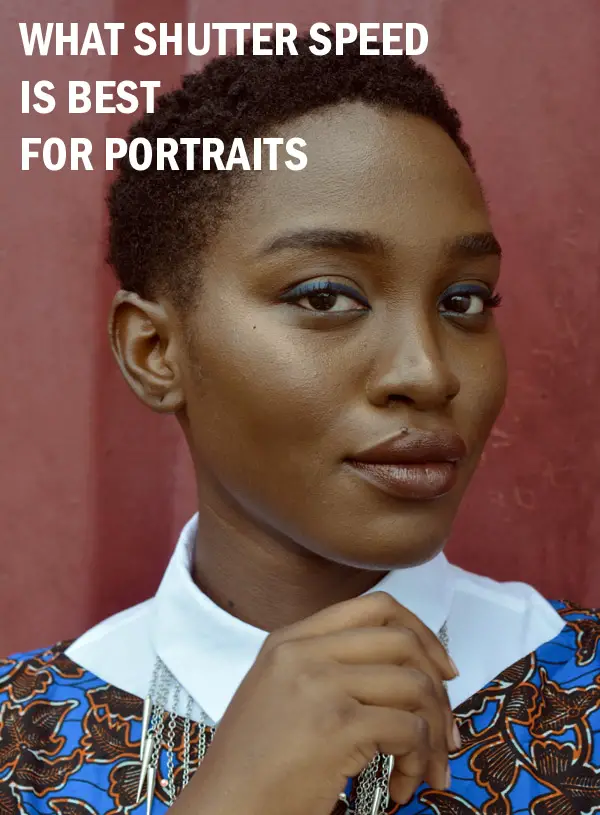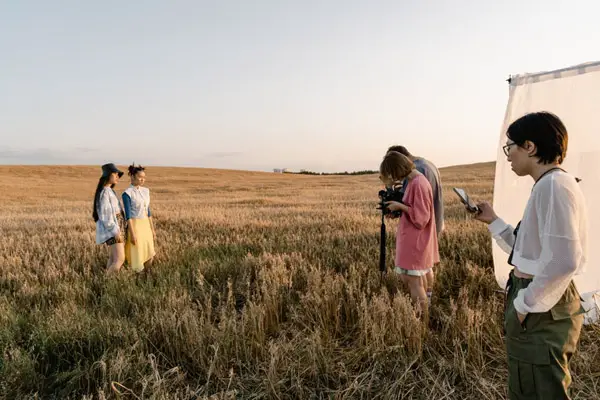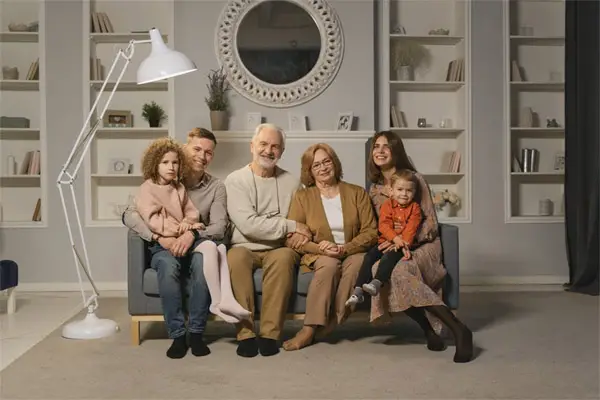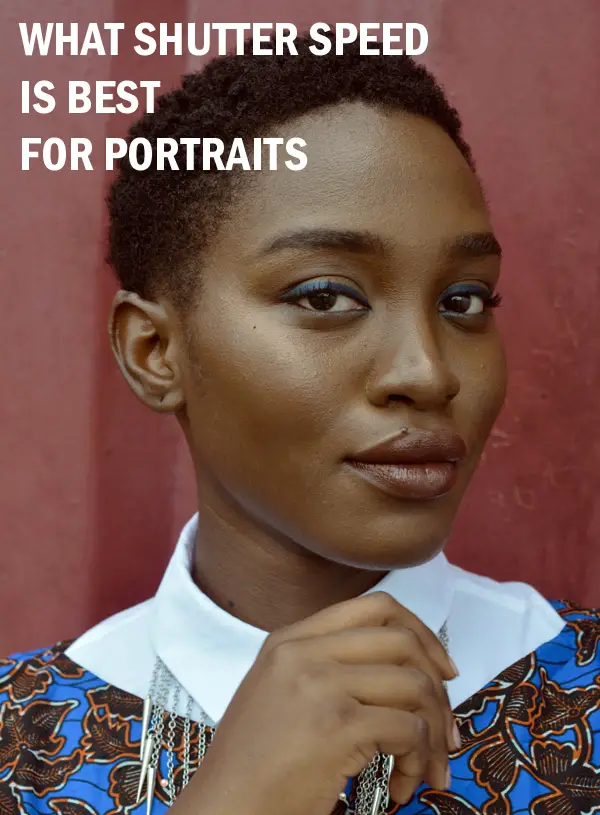When you first learn about portrait photography, shutter speed may be the last thing on your mind since it does not seem as important as in something like action or night photography.

In this article I will explain why shutter speed is important in portrait photography and what the correct shutter speed should be.
If you are handholding the camera, the shutter speed for the best portraits should be at least 1/200th of a second or 1/15th of a second on a tripod, with the 1/200th of a second being a commonly used due to the synch speed of most flash units.
But in some cases, especially where the subject can be completely stationary (not a portrait of kids), the shutter speed may not be as important. Read on to discover which shutter speed is the best for your type of portraits.
Factors Portrait Shutter Speed Depends On
Portrait shutter speed depends on several factors such as the image sensor, the length of time you expose the film to light and the object you are capturing. It also depends on any motion. The motion may either be frozen or blurry, depending on the shutter speed. It is therefore necessary that you understand how it works.
For portraits freezing action, you may need to use a faster shutter speed. But if you want to capture movement, you may need a slower shutter. Thus, you can use a slower shutter when photographing waterfalls or landscapes in your portrait. However, for most portraits, the best shutter speed should be about 1/200. But you may need to make adjustments depending on the type of portrait you want to capture including its background.
Equipment Considerations
The equipment you use is an important factor on which the portrait shutter depends on. So the results you get will depend on whether you will be using a tripod or holding the camera in your hands. Also, the lens of the camera is another vital consideration that may impact the images.
Using a flash in areas of low light is likely to help you maintain a fast shutter speed.
Environment
The environment in which you will be taking the camera is vital. Under the moonlight, you would need as much as 30 second shutter speed to get the desired portrait without external lighting. But if you will be taking the portrait on a bright and sunny day, using a shutter speed of between 1/500 s and 1/1000s will suffice. It helps to reduce capturing portraits that appear to be overexposed.
A faster shutter of about 1/640 s may be the most appropriate if you will be taking your portraits midday. Thus, controlling the brightness may be an important aspect when taking your portraits within varying environments. But when taking the photos in a darker condition, you may need a long shutter speed for brighter portraits. You may also need to pay attention to motion blur and movements, which may also play a role in determining the shutter speed you choose.
Outdoors
Many factors influence outdoor portrait photo taking, so you need to understand how the camera setting will work in a given environment. In most cases, it may require adjusting the shutter speed to suit the situation you find yourself in.
As you may be aware already, outdoor portraits in broad daylight may get more light than indoor portraits especially ones without flash, therefore shutter speed required would not be as slow as indoors.

If you are taking portraits of a single subject, an aperture of about f/4 may be the most ideal. But if you are shooting a group photo a less open aperture may be the most appropriate to get all your subjects sharp. Thus, the aperture, which refers to how wide your camera lenses open, counts.
Flash
Having a flash on your camera is a plus if you want to use it to take portraits. A flash could give you a bounce or pop light filling the shadows. Also, you may use it to add some light to your portrait. You can do this by varying the flash angle to add some interesting things to the portrait. The flash comes in handy when taking portraits for weddings and family functions.
A flash helps the photographer take well-lit portraits without spending so much money on expensive lighting kits. If you know how to use the flash properly you are likely to achieve great looks and end up with quality portraits.
Having a flash gives you the portability you may need without carrying extra gear. It allows you to use flash off or flash on camera depending on the situation you find yourself in. Also, a flash helps to give your portraits better exposure enabling your clients choose images that are well lit. It thus, gives them a variety of images to choose from. Also, it means that you spend as little time as possible working on and editing images.
But the challenge you are likely to face is to choose a flash system that is good for you. However, if you choose one that you can use in TTL or manual mode, you will have a wider range of options during your portrait-taking sessions.
Also, it may require that you choose a flash system compatible with the camera you will be using. Ensure that it works with the camera brand. Such a camera will give better results since setting it up is easier. In addition, you will spend as little time as possible learning and experimenting using the camera.
The through-the-lens (TTL) mode allows the flash to meter the light before choosing how much light to emit when taking the photo. The results may vary depending on the frame, but it can be helpful when you want the camera to take images under different conditions without changing the settings. It allows you to choose less light or more light depending on the kind of portrait you want to achieve.
On the other hand, the manual mode will set your power output between 1/128 and 1/1. This will give you control over the light your camera can fire on the subject. Also, it allows you to adjust the light as you move along. Further, it gives a more consistent output since it may require that you set it once and use it whenever you want. However, you have the freedom of choosing any other new settings you may want at any time.
What Speed Is Too Slow for Portraits?
Shutter speed is critical in determining the kind of photos you get. A shutter speed slower than 1/125s will not be fast enough for an action portrait. It will only be fast enough to stop slow motion of a person.
Light is important when taking images and determines the type of portraits you end up with. For handheld photographs, different scenes require different adjustments. So the aperture and shutter speed will be responsible for the amount of light hitting the sensor and the depth of the field.
However, photographing at night, choosing a higher shutter speed may result in underexposed portraits. In this case, the shutter may close too fast and may not allow enough light in. On the contrary, choosing a too slow speed overexposes the scenes and will still create a blurry motion. This may make it difficult to get sharp pictures.
Also, if you take the images from a distance, you will need a longer focal length which requires a faster shutter speed. The image may shake a lot, and more moves will be in the frame. As such, it may be necessary that you balance this by increasing the speed of your shutter to make the images sharp.
Shutter Speed for Family Portraits
Generally, the shutter speed should be twice the focal length, for example if you use a 100mm prime lens the shutter speed should be 1/200. Thus, alongside ISO and aperture, the shutter speed is the most important factor that contributes to the photos’ exposure. Therefore, knowing how to use the shutter speed will determine the type of photos and images you get. You are likely to have more creative shots that are sharp and good to look at.

Kids never stay still and can suddenly move around, which means you need to increase your shutter speed as compared to one adult sitting still patiently. Anything faster than 1/100 could be fine but if you have enough light, you might as well freeze the action at 1/200 or 1/400.
Of course, it will guarantee you better results if you take photos at a shutter speed of between 1/100 and 1/600th. Such a speed allows one to freeze the movements of objects and increase clarity. Therefore, if you are interested in having sharp family portrait images, avoid slower shutter speed.
Below is a useful video on what settings to use for portraits:
Now that you’ve learned about the best shutter speed for portraits, how about you understanding more about the shutter speed in general? Click on the following link to learn more about shutter speed, and its dependence on the aperture and ISO.









